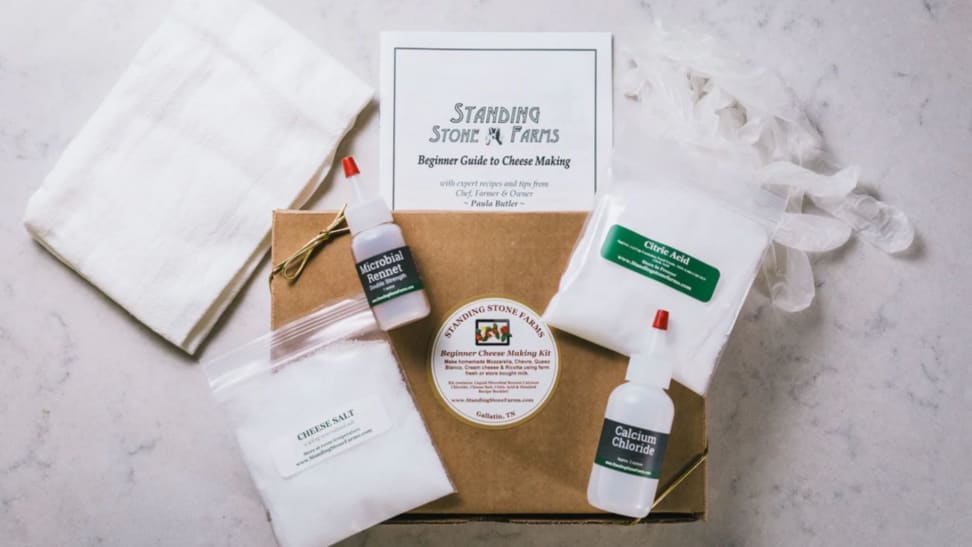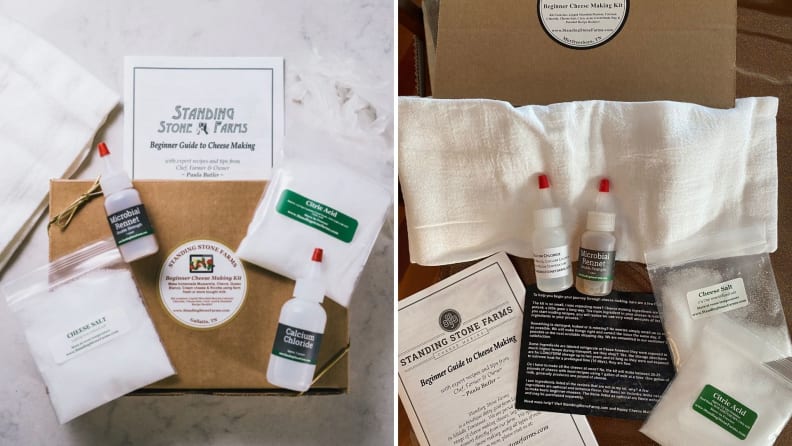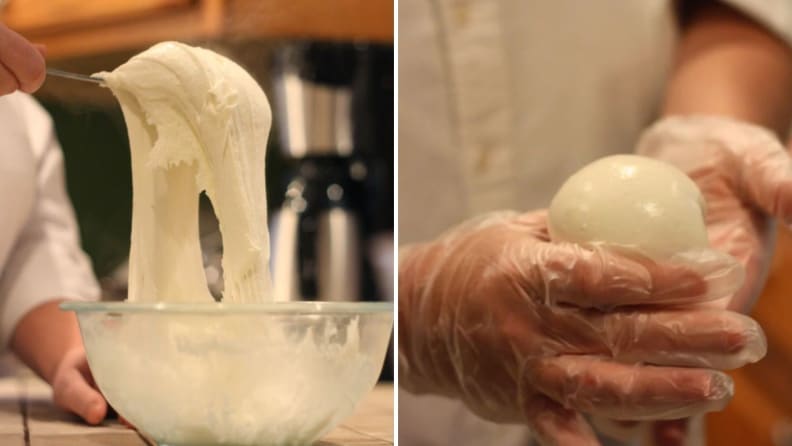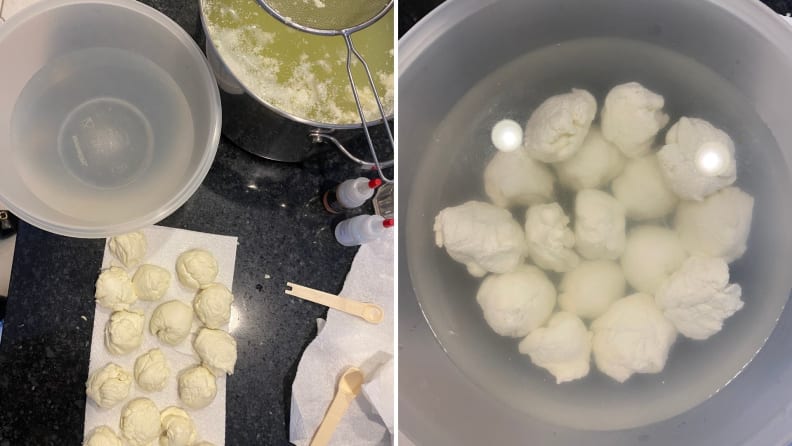Standing Stone Farms Beginner Cheese Making Kit Review
I tried a DIY cheese kit to see if it's worth the effort
 Credit:
Standing Stone Farms
Credit:
Standing Stone Farms
Products are chosen independently by our editors. Purchases made through our links may earn us a commission.
If you're anything like me, you have a long history of eating cheese, but a short (read: nonexistent) history of making it. Ever since DIY kits of all shapes and sizes have grown in popularity, though, the idea of making cheese at home has enticed me more and more. What would it be like to make my own cheese? Would it taste better than store-bought? Would I soon love cheesemaking as much as I love cooking and baking?
I spent a lot of time talking to cheesemakers, as well as writing and reading about the process during my time at Culture Cheese Magazine, but I never actually got my hands dirty in a bucket of curds and whey. That's why I was a little apprehensive about making my first-ever batch of homemade mozzarella with Standing Stone Farms Beginner Cheese Making Kit. But given that it was labeled and marketed as "Beginner"—and that it had a glowing 4.5 stars on Amazon—I felt a little more confident in starting my cheesemaking journey.
What's in the kit

There was one thing missing from my DIY Beginner Cheese Making Kit: Plastic gloves.
Standing Stone Farms is a cheesemaking supplier based out of a small goat dairy farm in Tennessee that sells equipment and kits for cheesemaking, allowing folks to try their hand at making anything from ricotta to feta to ghee at home.
I opted for the beginner kit, which provides only the bare-bone essentials: citric acid, organic microbial rennet, calcium chloride, cheese salt, a drain cloth, and a recipe booklet. (The website also lists disposable gloves as being included in the kit, but I didn't receive any in mine.) This kit includes the ingredients to make mozzarella, cream cheese, chèvre, queso blanco, mascarpone, and ricotta.
Since this is the smallest of the kits, it doesn't include equipment like a pot, slotted spoon, or mesh strainer. But the first few pages of the booklet provide a detailed list of equipment needed, along with sterilization instructions and which milk to buy at the store (or from your local farmer).
What I like about Standing Stone Farms' Beginner Cheese Making Kit

This small kit provides enough supplies to make 25–30 milk gallons' worth of cheese.
It provides some helpful and informative background information
In some ways, this booklet goes above and beyond in briefing cheesemaking newcomers to the world of fromage. Right off the bat, the table of contents marks each recipe as either "Easy Cheesy" or "Not So Easy Cheesy" to mentally prepare folks on the difficulty level of each cheese type.
There are also informative sections like "A Brief History of Cheese" and "Glossary of Terms" that may not necessarily be crucial for beginner cheesemakers, but provide some useful background information to help folks feel all the more prepared to dive into what could be an intimidating experience. (It's also helpful to know what things like lactic acid and rennet even are before plopping them into your pot.)
It includes adequate materials to make over 10 batches of cheese
For some reason, I assumed this would be a one-and-done situation, where I'd make a (really expensive) singular batch of mozzarella and leave my cheesemaking days behind me—at least until the next kit comes along. Instead, I was surprised to realize that this small kit provides enough supplies to make 25–30 milk gallons' worth of cheese (most recipes only call for one-to-three gallons at a time). That means you can explore every single cheese recipe in the booklet—and some of them more than once.
What I don’t like

The results of my hard work were less than satisfying, thanks to a lack of instructions.
The recipes don't provide a time estimate
It was great to see the difficulty levels laid out for all cheese recipes in the booklet, but each individual recipe did not provide an estimated amount of time to complete it. For those who are brand new to cheesemaking, this might be frustrating.
I'm used to most recipes I find—in either recipe books, online, or from meal kit companies—providing prep and cooking estimates that allow me to allot specific times in my busy schedule. And since I had no other cheesemaking experience to compare this to, I wasn't sure whether this would take me 20 minutes or four hours. I ended up doing some googling to guesstimate how long it would take to complete an average mozzarella recipe, and concluded that—according to a few different sources—I should be relishing the fruits of my labor after about 30 minutes. (In reality, it took me over an hour.)
The step-by-step guide isn't detailed enough for beginners
For recipes that are precise, prioritize science, and require the utmost attention-to-detail (like cheesemaking), I always read instructions several times over to be sure I don't miss any important steps. And for the first half of this process, that seemed to work out for me. I followed each step to a T, making sure not to skip anything, and before I knew it I was separating curds from whey and stretching mozzarella with my hands. But that's where things fell astray.
Forming the spheres might be the most crucial part of the mozzarella making process, but it was also the part of the recipe with the most vague instructions. The final step, when it comes time to shape, says to "work [the cheese] into a ball shape with your hands and allow to cool. The cheese should become shiny and smooth. Drop the balls into a cool salt water solution for 10 minutes to chill so that they can retain their shape." I had no idea what "working" mozzarella meant—and I definitely didn't know that this all had to be done while it was still scorching hot from the previous step (which I found out too late, when the shapes became neither smooth nor shiny). The directions also don't guide you on the ideal size of the mozzarella balls, how many there should be, or what the best way to shape them is.
I should point out that Standing Stone Farms does offer a DVD on their website, which has step-by-step visual instructions for cheesemaking. But since that doesn't come with the kit, I still believe that someone without any supplementary additional aids or background knowledge should be able to follow the recipe booklet successfully with what they're provided. But additional descriptive language—or, even better, some photographic visual aids—would have helped guide cheesemaking novices more successfully.
The result wasn't very tasty
Full disclosure: It's very possible that my final result (a bowl of unappetizing mozzarella) was due to the fact that I didn't stretch the cheese correctly, and not due to the ingredients Standing Stone Farms provided. But it's still important to note that I found the flavor and texture in these completely wrong. The exterior of the cheese had an off-putting softness to it, while the interior of the ball was somehow the hardest mozzarella I've ever tasted—requiring more force than expected to cut through it with a fork.
The flavor was also off, tasting more salty and cheesy than fresh and milky. And since I measured each ingredient religiously, I believe that the same flavor would have existed even if I formed each ball to perfection.
Is making your own mozzarella with this kit worth it?
Not unless you have some background knowledge or experience
Back when I was "working" my mozzarella batch, my mom watched my sad attempts at stretching and came in to explain a different technique, saying this is how one of her friends (who, go figure, used to work at a mozzarella factory in Italy) does it. Without her small tip, I don't know if I would've been able to even finish this recipe at all.
All that said, if you're passionate about the idea of making your own cheese at home—and you have no experience—it's not impossible to be successful with one of these kits. I do recommend, however, doing some research first. Watch videos online, read more about the mozzarella making process, or order Standing Stone Farms' DVD tutorial before you do so, to know what you're getting yourself into and be more prepared.
When it comes to flavor, I can't fully speak to whether or not homemade cheese (when it's appropriately made using a DIY kit) is better than store-bought, since my experience didn't allow for optimal results.
Eating homemade mozzarella from my mom's experienced friend, for example, is definitely a treat. But that might just be another argument in favor of leaving cheesemaking to the experts.
Get Standing Stone Farms' Beginner Cheese Making Kit
Get Standing Stone Farms' Cheese Making DVD
You’re on your way to becoming a kitchen master. Take the next step and sign up for Chef's Course. You’ll get weekly tips, tricks, and recipes from top chefs sent straight to your inbox. It’s a whole master course for free.



